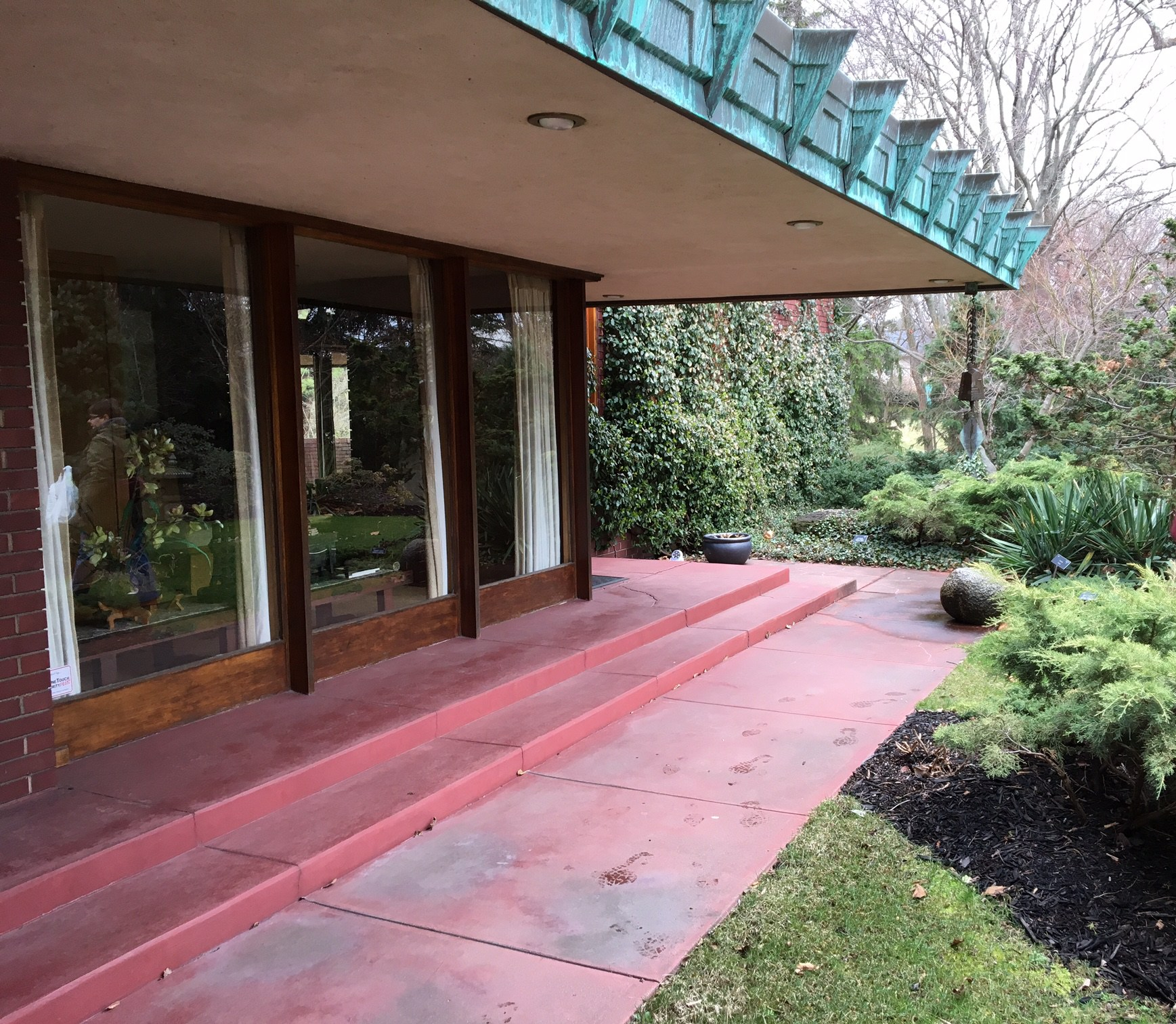
Category Archives: Quotes
What do I mean by “Big Love”?
Samara Is A Real Place
 Samara, one of the key locations in my novella “Big Love” (Scrivenings Press) now available for preorder on Amazon, is a real place. It’s about an hour and ten minutes north of me in West Lafayette, just off I-65. It is one of the last houses architect Frank Lloyd Wright envisioned and had built in his Usonian style.
Samara, one of the key locations in my novella “Big Love” (Scrivenings Press) now available for preorder on Amazon, is a real place. It’s about an hour and ten minutes north of me in West Lafayette, just off I-65. It is one of the last houses architect Frank Lloyd Wright envisioned and had built in his Usonian style.
And I never knew it existed—until I needed it.
In that sense, Samara is rather like J.K. Rowling’s fictional creation, The Room of Requirement, in her Harry Potter series of novels. That room appears, stocked with whatever the magician requires at the moment, just as it is needed. And until it is needed, it cannot be found.
Only, as I said, Samara is real. You can visit it and I highly recommend you do.
In my novella, my architecturally-minded journalist and my as-independent-as-Yankee-Doodle small business woman who builds tiny houses for the homeless, needed a place they could explore together to deepen their relationship—and divide them.

Everything you see, including the china, was designed by Wright.
I knew I needed this almost magical place where the natural attraction these two feel for each other could be easily intensified. It’s a novella, after all, there wasn’t a lot of time.
As I searched for the right location—I wanted a real one, not something made up—I knew Purdue University had a great school of civil engineering and that south of Indianapolis is the city of Columbus, renown for its architecture. So this got me thinking about what architectural marvels might be found in Indiana. I fully expected to make a road trip or two to Columbus for exploratory purposes.
But when I searched online for architecture in Indiana, I found this 2014 article from Indianapolis Monthly magazine: “Milestones: An Indiana Architecture Road Trip,” by Daniel S. Comiskey. As I read through the piece, the name “Samara” lit up like neon in my mind.
And the location in West Lafayette couldn’t have been more perfect. My journalist, Nathan “Rafe” Rafferty, lives in Chicago. My builder, Timberly “Berly” Charles, lives in Indianapolis. Connecting them is I-65 and almost exactly in the middle is—Samara.
You hear it too, don’t you? When you read “Samara,” doesn’t it sing? Don’t you almost hear Hervé Villechaize’s Tattoo calling out, “The house! The house,” as Ricardo Montalban’s Mr. Roark strolls nonchalantly onto the veranda?
A quick email to Linda Eales, Samara’s associate curator, secured a visit to the home for my wife and I. And yes, until very recently Samara was a home and a museum. The original owner, Purdue University professor John Christian, and his wife Catherine, lived in the home until their deaths. It is now operated by the John E. Christian Family Memorial Trust and is open to the public.
Here’s a bit of a scene from my character’s visit to Samara. In the living room of the house, Berly and Rafe experience the calming effects of the room’s architecture. The scene is in Berly’s point of view:
Wall-sized windows fill an entire side of this amazing great room that was created before the concept of great rooms. A line of cushioned benches underneath a wall of shelves for books and knickknacks extends into and around the corner of the library section of the room.
Linda talks about how the design, the integration of nature—“With a capital N as Wright would say”—and the unity of the lines in the house create a feeling of peace and relaxation today’s homes often don’t have.
The corner Wright called “the best seat in the house.”
She motions to the library’s distant corner. “Wright would have said that corner bench is the best seat in the house.”
I move into that corner to look at the amazing display of books and other decorative pieces on the shelves.
Rafe follows me. “Don’t you want to sit?”
“Oh, I couldn’t.” To me, this is a museum, and that means Do Not Touch. But Linda confirms Rafe’s invitation.
“No, it’s all right,” she says. “Dr. Christian lived in the home until his death in 2015. The furniture is intended to be used.”
So I do, and Rafe sits next to me. I am sitting on a piece of furniture designed by Frank Lloyd Wright.
“I’ll dim the lights,” Linda says. “That will help you feel the peace.”
As we sit there, in the quiet and in the natural light of a sunny Hoosier afternoon, a calm does descend. My breathing evens out, and my body relaxes. It’s the first time I’ve noticed how architecture can be used to create mood—and I love it. How can this be incorporated in our work at La Petite Maison?
Rafe rests his hand protectively over mine on the seat cushion between us. It scares me to even think about it, but I am beginning to wonder about the future with Rafe. Sitting next to him, I swear I hear some pieces of my life fall into place. I try to lean into the peace and enjoy it. I don’t find it often.
“What are you feeling?” he whispers in my ear, his warm breath accentuating his words.
What am I feeling? I can hardly tell him, now can I? But I am feeling.
Just a short scene or two later, trouble descends in paradise and the comforts of Samara get lost as the characters… well, you’ll just have to read it!
And you can! Why not preorder a copy today? I’d be honored if you left a review on Amazon and/or Goodreads after you’ve finished. Thanks in advance!
Quote It! Writers and Food
Today, three great quotes from authors that connect writing and food–the two essentials in any writer’s life!
Food fuels, literally, my writing. But, in many ways my writing also fuels my eating. I find when I’m about to give birth to a new project, I crave my comfort foods–chocolate (of course), and the three P’s: pasta, pizza, and popcorn.
 “Am I tough? Am I strong? Am I hard-core? Absolutely. Did I whimper with pathetic delight when I sank my teeth into my hot fried-chicken sandwich? You betcha.”
“Am I tough? Am I strong? Am I hard-core? Absolutely. Did I whimper with pathetic delight when I sank my teeth into my hot fried-chicken sandwich? You betcha.”
― James Patterson, who in the past three years, has sold more books than any other author (according to Bookscan), is the author of the top-selling Alex Cross detective series that includes Along Came a Spider and Kiss the Girls, both made into films. To date, Patterson has had 19 consecutive #1 New York Times bestselling novels.
 “We must have a pie. Stress cannot exist in the presence of a pie.”
“We must have a pie. Stress cannot exist in the presence of a pie.”
― David Mamet, the Pulitzer Prize-winning playwright of Glengarry Glen Ross (1984) and Speed-the-Plow (1988), and the screenwriter of The Verdict (1982) and Wag the Dog (1997).
 “If more of us valued food and cheer and song above hoarded gold, it would be a merrier world.”
“If more of us valued food and cheer and song above hoarded gold, it would be a merrier world.”
― J.R.R. Tolkien, (1892 – 1973) was an English writer, poet, philologist, and university professor, best known as the author of the classic fantasy works The Hobbit, The Lord of the Rings, and The Silmarillion.
What are the foods that fuel your writing? What food do you turn to when things aren’t going well? When you’re about to kill a character, do you amp up the caffeine? What are your food and writing connections?
__________________________________________
Michael Ehret, for Writing on the Fine Line
 Michael loves to play with words and as editor of the ACFW Journal, he is enjoying his playground. He also plays with words as a freelance editor here at WritingOnTheFineLine.com, where he often takes a writer Into The Edit, pulling back the veil on the editing process. He has edited several nonfiction books, played with words as a corporate communicator, and reported for The Indianapolis Star.
Michael loves to play with words and as editor of the ACFW Journal, he is enjoying his playground. He also plays with words as a freelance editor here at WritingOnTheFineLine.com, where he often takes a writer Into The Edit, pulling back the veil on the editing process. He has edited several nonfiction books, played with words as a corporate communicator, and reported for The Indianapolis Star.
Quote It! Chuck Colson
 “At the root of what makes us good, just, and decent, is a recognition that we owe a debt to those who have gone before us.”
“At the root of what makes us good, just, and decent, is a recognition that we owe a debt to those who have gone before us.”
–Chuck Colson, Watergate figure who emerged from the country’s worst political scandal a vocal Christian leader and a champion for prison ministry, spent the last years of his life in the dual role of leading Prison Fellowship, the world’s largest outreach to prisoners, ex-prisoners and their families, and the Colson Center, a teaching and training center focused on Christian worldview thought and application. Colson died in April of 2012.
__________________________________________
Last night, our small group finished the study Doing The Right Thing. This quote from Colson was one of the last statements made in the video.
I can’t get it out of my mind.
The statement is truth for each of us, but for the Christian the debt both deepens and enriches. In a Kingdom economy, the debt we owe is one of love:
8 Don’t owe anyone anything, with the exception of love to one another—that is a debt which never ends—because the person who loves others has fulfilled the law.
(Romans 13:8, The Voice)
But what does it mean to me as a writer? Certainly I owe a debt to my parents and siblings who nurtured me–and to my wife who never fails to believe–but also to my writing teachers from first grade (Mrs. Oyer at Hawthorne Elementary) through college (Kim Peterson at Bethel College).
But many others have invested in me as a writer and editor–including many of you who are reading this now. To each I owe my thanks, but also my commitment to use what you willingly gave from your storehouse. There is one other thing: I owe to those who come after me, my own willingness to share, encourage, and educate.
Together we make a chain–and we make each other “good, just, and decent.”
Colson’s quote was one of the last things the video lesson shared. The last thing was this:
“Gratitude is the mother of all virtues.” — G.K. Chesterton
__________________________________________
Michael Ehret, for Writing on the Fine Line
 Michael loves to play with words and as editor of the ACFW Journal, he is enjoying his playground. He also plays with words as a freelance editor here at WritingOnTheFineLine.com, where he often takes a writer Into The Edit, pulling back the veil on the editing process. He has edited several nonfiction books, played with words as a corporate communicator, and reported for The Indianapolis Star.
Michael loves to play with words and as editor of the ACFW Journal, he is enjoying his playground. He also plays with words as a freelance editor here at WritingOnTheFineLine.com, where he often takes a writer Into The Edit, pulling back the veil on the editing process. He has edited several nonfiction books, played with words as a corporate communicator, and reported for The Indianapolis Star.









